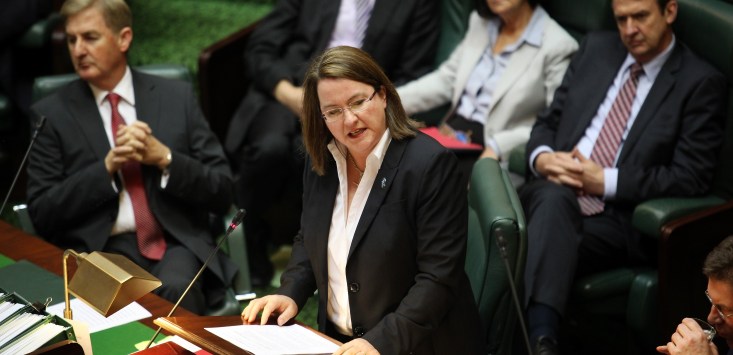
Workplace Gender Equality Agency director Mary Wooldridge. (AAP Image/Paul Jeffers)
A slight improvement in the national gender pay gap to 13.3% has been reported with the release of new data, bringing the current status quo to Australian women pocketing, on average, 87 cents for their work to every dollar earned by a man.
Back in 2020, when Australia recorded the gender pay gap at its most narrow, the difference in average earnings between the genders was 13.4%.
The improvement was calculated by the Workplace Gender Equality Agency (WGEA) on Thursday when the Australian Bureau of Statistics (ABS) released the latest average weekly earnings data.
It showed that as of November 2022 women working full-time earned $253.50 less than men each week.
Australian women’s weekly ordinary earnings across all industries and occupations was $1,653.60 compared to $1,907.10 for men.
A closer look at the pay gap by industry showed the category of ‘public administration and safety’ had a 6% gap.
WGEA director Mary Wooldridge noted that the increasing cost of groceries, energy, fuel and housing was disproportionately affecting those who are paid less in the workforce — overwhelmingly, women.
“The gender pay gap is a handbrake on women’s ability to make ends meet. With inflation at 7.8%, and rising, everyday essentials are becoming increasingly unaffordable,” Wooldridge said.
“Women are $253.50 worse off every single week as a result of their gender.”
The agency boss also stressed the latest pay gap data only considered the base salary for full-time workers.
The gender pay gap for total remuneration tends to be 5% wider than that of base salaries.
“Over the course of one year, the weekly difference of $253.50 adds up to $13,182 [for women]. That’s income that could have gone towards meeting bills, mortgage repayments or additional contributions to superannuation funds for retirement,” Wooldridge said.
“Today’s gender pay gap also doesn’t include the wages of part-time or casual workers, many of whom are lower paid and also women.”
The headline did not accurately reflect the true unequal distribution of wealth or value of work in society, Wooldridge said, because it overlooked other potential benefits like bonuses, overtime payments and superannuation.
Australia’s national gender pay gap is 13.3%.
We know the causes, we know the solutions. What we need now is action.
Want to know more about this calculation? Read more on our website: https://t.co/tPDIoqD0V3
More to come. pic.twitter.com/rF3nthCEvL
— WGEA (@WGEAgency) February 23, 2023
A breakdown of the average remuneration difference for women and men and women across the states and territories showed the widest gap in WA (22.1%), Queensland (14.6%), the NT (14.2%) and Victoria (13.4%). This was followed by NSW (11%), the ACT (10%), SA (7.8%) and Tasmania (6%).
WGEA’s message to employers and business leaders was simply that failure to do anything about their internal pay gaps reinforced the view women’s work was of less value than men’s. Until this happened across society, improving outcomes for Australian women, their families and communities would be challenging.
“Gender pay gaps are a reflection of the way we value women’s and men’s contributions in the workforce,” Wooldridge said.
“Employers who don’t make gender equality a priority will fail to attract and retain female talent and won’t benefit from the increased productivity, innovation and profitability that flows from embracing diversity in your workforce.”
This article was first published on The Mandarin.
Handpicked for you

Advocates push the envelope on paid parental leave before Senate inquiry



COMMENTS
SmartCompany is committed to hosting lively discussions. Help us keep the conversation useful, interesting and welcoming. We aim to publish comments quickly in the interest of promoting robust conversation, but we’re a small team and we deploy filters to protect against legal risk. Occasionally your comment may be held up while it is being reviewed, but we’re working as fast as we can to keep the conversation rolling.
The SmartCompany comment section is members-only content. Please subscribe to leave a comment.
The SmartCompany comment section is members-only content. Please login to leave a comment.